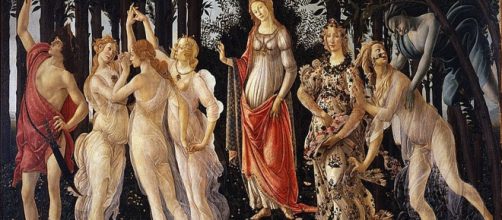Can a 544-year-old painting of mythic gods and goddesses matter today in any internal way? Can it, say, lighten hearts, even those hardened by a government shutdown? Academic opinion on Sandro Botticelli's Primavera suggests that it's possible. The artist is in the news for a show of his work at the Isabella Stewart Gardner Museum in Boston starting Feb. 14, and ArtDaily, reporting on the show, classes Primavera as the “cornerstone of his fame.”
Shall we dance?
Primavera, originally titled Venus, was renamed by the 16th-century Art historian Giorgio Vasari, who saw it as the preeminent symbol of the miracle of spring.
What you see is Venus, goddess of love and her court dancing in a flower-filled garden amid floating veils light as mist. Art critic Charlotte Willard included the painting in her 1961 book “What Makes A Masterpiece?” contending that “no one in the history of art has ever been able to feel springtime as he has.” She cited the tender beauty that Botticelli graced Venus and her followers with. And the sight of those figures weaving in and out of the colorful tapestry of awakens the senses like notes of music, she said.
The vision so enchants that she gives credence to the idea that viewers can catch whiffs of the floral fragrance from the garden, imagine feeling the soft breeze rustling the garden trees, and even sense the faint rhythm of the dancers' bare feet on the earth.
New beginnings
As for why Willard considers Primavera a masterpiece, she explains that one of the things a masterpiece does is make viewers feel what they see and know. Accordingly, by looking at Botticelli's painting, she says you can actually experience the cool, spring sun. I'm with her on that. Seeing Primavera is a little like looking through rose-colored glasses, something unimagined now in a world that has lost its innocence.
At the very least, the painting can be viewed as a dream of hope that comes with the end of winter and the start of spring, a picture of renewal.
Of course, another possible reason the painting can be such a visceral event is its mammoth size - over 10 feet long and nearly seven feet high. But that can't be the reason. Even the grand scale wouldn't explain why the picture has made Botticelli famous to this day.
After all, Mona Lisa's near-miniature dimensions (30 by 21 inches) hasn't diminished its popularity.
The sound of music
One more thing. While Primavera is Botticelli's interior vision of spring, it's also one of love. You may recognize his Venus in this painting from his other poetic dream, Birth of Venus, which shows the pagan goddess being born from the sea and transported to shore on a seashell. Botticelli's message isn't all that different from the one that Dionne Warwick intended in her song lyrics, “What the world needs now is love, sweet love.”


